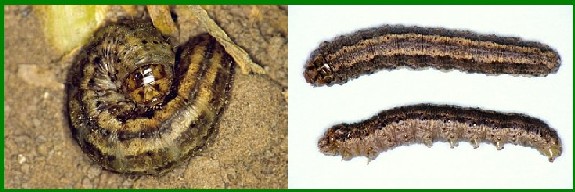
University of Nebraska Department of Entomology
Army Cutworm

University of Nebraska Department of Entomology
Update March 24, 2004
Army Cutworms are Potential Problem in Alfalfa and Wheat
Recent reports indicate that some wheat and alfalfa fields just breaking dormancy in Buffalo County have heavy cutworm populations. These are most noticeable when they migrate out of the fields and climb the south walls of homes seeking the warm sunlight.
Army cutworm moths are active in September and October when they lay their eggs in the soil. The eggs hatch shortly after they have been exposed to moisture (i.e. rainfall). Larvae continue to feed as long as temperatures are favorable, and partially grown larvae over winter in the soil. Larval feeding activity resumes in late winter or early spring when soil temperatures increase.
Due to their need for winter vegetation, these cutworms are only likely to over winter where winter wheat, alfalfa, grasses or weeds are present. Army cutworms become active at relatively cool temperatures, possibly even below 40°F, because solar heating warms soil temperatures well above the air temperature. Feeding continues through the spring. Fully-grown larvae burrow into the soil, create an earthen chamber, and pupate. Adults emerge from the soil in May and early June to complete the life cycle.
Army cutworms are most often a threat to wheat and alfalfa in early spring, just as these crops break dormancy. We recommend checking your wheat and alfalfa fields for the cutworms as soon as possible, before they delay spring re-growth. The cutworms feed at night but may be found on plants on some cloudy days. During the day, they will be found buried in the loose soil and debris or under soil clods.
Treatment decisions should be based on the number of cutworms present, the amount of damage, and the plant’s ability to outgrow this damage. In poorly growing wheat or in alfalfa seeded in 2003, two or more army cutworms per square foot may warrant treatment. The threshold for treatment of cutworms in healthy wheat or established alfalfa fields is four or more cutworms per square foot.
It is important to consider the plant’s ability to outgrow the defoliation damage as well as the number of cutworms present, when trying to determine whether treatment is necessary
Army cutworms derived their name, at least partly, from their habit of “marching” from alfalfa fields across roads and onto houses. Although they are probably looking for something to eat, they presence around the home is probably more of a nuisance than a threat to eat on carpet, curtains or inorganic things in the home.
Various pyrethroid insecticides will provide emergency control of cutworms. Contact your pesticide supplier for the pesticides that are available locally.
Other Recources
http://ianrpubs.unl.edu/insects/g1145.htmhttp://entomology.unl.edu/images/smgrains/armyworm/armyworm.htm